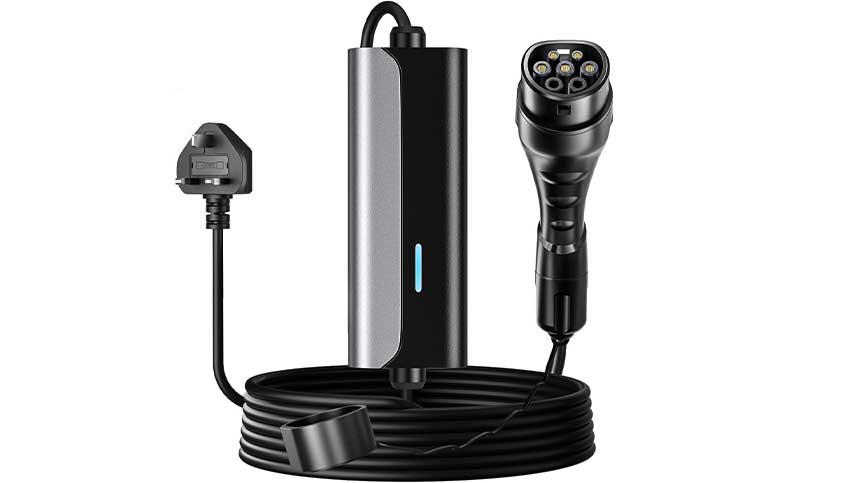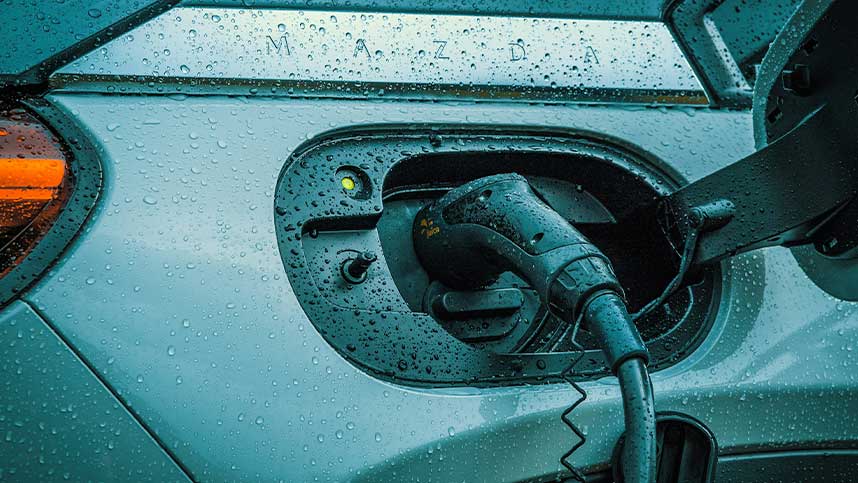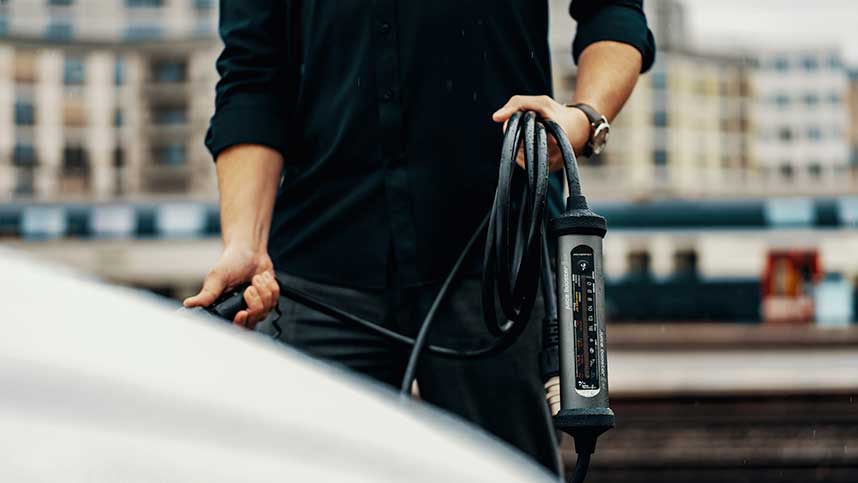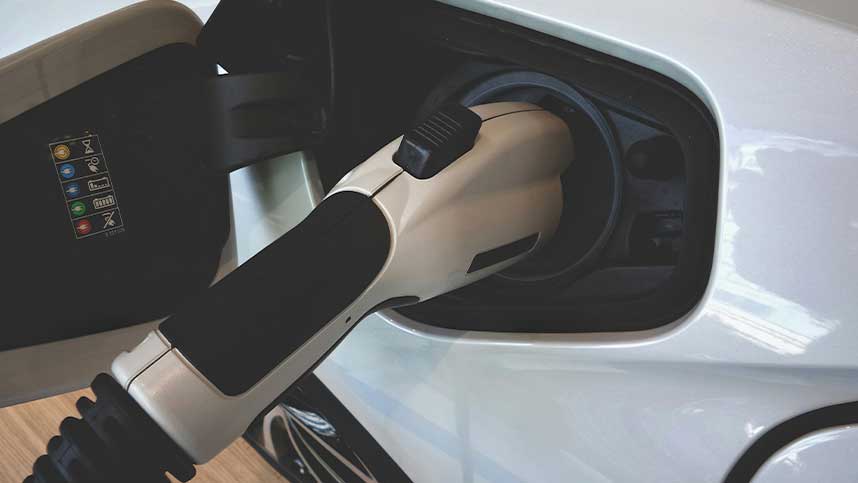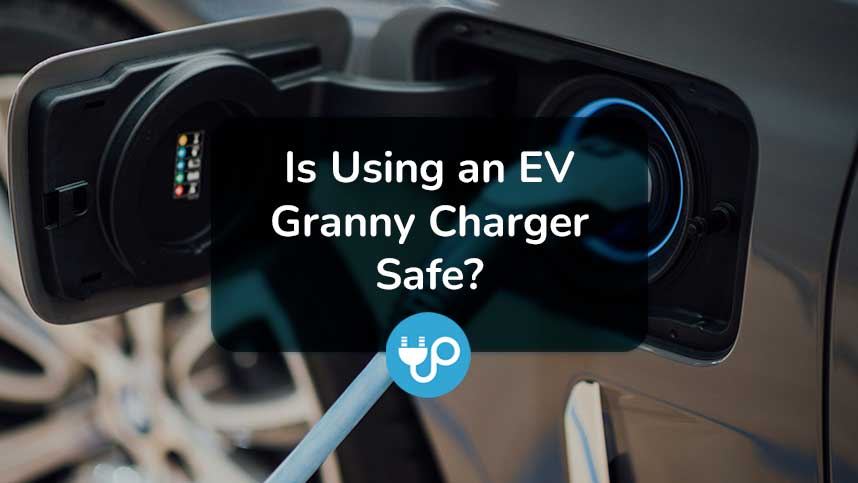
Is Using an EV Granny Charger Safe?
Electric vehicles (EVs) are now a common sight on UK roads, and with them comes the need for easy charging solutions.
One such solution included with many EVs is the ‘granny charger’, a nickname for the portable charging cable that plugs into a standard household socket.
This basic charger is handy and easy to use, but many new EV owners wonder: is using an EV granny charger safe to charge your car using a normal 3-pin plug at home?
In this article, we will explain what an EV granny charger is, how it works, discuss its safety, why people use it, ways to minimise risks and finally give our conclusions on its safe use.
Chapters
What is an EV Granny Charger?
An EV ‘granny charger’ is the informal name for the portable charger that often comes with an electric car.
It allows you to charge the vehicle from a standard 240-volt household mains socket – the same type of socket you might plug a kettle or lamp into.
The term ‘granny charger’ caught on because it implies a slow, steady charge, perhaps something you’d use when visiting your grandmother’s house where only a normal socket is available.
Essentially, it’s the emergency or occasional-use charger for your EV, used when a dedicated charging point isn’t accessible.
In practical terms, a granny charger is a cable with a three-pin 13-amp UK plug on one end and your car’s specific charging connector (Type 1 or Type 2, depending on the vehicle) on the other.
How Does a Granny Charger Work?
Using a granny charger is straightforward: you plug the three-pin end into a wall socket and the other end into your electric car’s charging inlet.
But what’s happening behind the scenes to make this safe for your car and home?
The granny charger is technically a Mode 2 EV charging cable, which means it incorporates an electronic device in-line that communicates between the car and the power supply.
Inside the small control box on the cable, there are electronics that perform several important jobs.
First, when you connect it, the box signals to your EV’s onboard charging system that it’s a ‘ready-to-charge’ source and it specifies the maximum current it can provide (usually about 10 amps for UK granny chargers).
This communication follows a standard protocol so that the car knows it should only draw a limited amount of power.
Only once the car and charger have ‘agreed’ on the settings, does the box allow electricity to flow from the socket to the vehicle.
Is Using an EV Granny Charger Safe?
The big question for many drivers is whether using an EV granny charger is safe.
In general, the answer is yes – but only if the charger is used correctly and under the right conditions.
A granny charger supplied by your car’s manufacturer or a reputable brand is designed with built-in safety features and is tested to meet strict electrical standards.
When used properly, it should not damage your vehicle and can provide a safe, steady charge.
Many drivers use granny chargers at home, particularly for plug-in hybrid vehicles or for the occasional top-up of a fully electric car.
However, safety depends greatly on the condition and quality of the electrical socket you’re plugging into, and you should only use sockets that are BS 1363-2 compliant.
Overnight Use and Risks from Household Wiring
Granny chargers draw around 10 amps continuously for several hours.
This might not seem like much, but it places a high and sustained load on your home’s electrical system, especially overnight, when charging typically lasts 8 to 12 hours.
Standard household sockets weren’t originally designed to deliver high power for long periods.
Appliances like kettles or toasters only draw high power for a few minutes, and even fan heaters (which run for longer) often pull less current than an EV charger.
If the socket has loose contacts, signs of wear, or is part of an old or overloaded circuit, it could overheat.
The result can be scorched plug pins, melted plastic, or even an electrical fire.
Use Only Compliant Sockets
You should only use a socket that complies with BS 1363-2.
Specifically, look for sockets that are:
- Marked EV on the rear plate
- Designed for continuous high-load operation
- Installed by a qualified electrician on a dedicated circuit
These sockets are tested to handle sustained loads safely and are the best choice for granny charger use, particularly if you charge your EV overnight.
Common Mistakes to Avoid
Many incidents linked to granny charging are caused not by the charger or vehicle, but by poor setup or unsuitable equipment.
Here are some common problems:
- Using cheap or low-quality extension leads
- Plugging into non compliant or damaged sockets
- Relying on multi-plug adapters or reel-type cables
These all add electrical resistance and can cause dangerous heat build-up.
There have been real cases where plugs have fused into sockets or leads have melted during overnight charging.
Key Safety Reminders
Always plug the charger directly into the wall (avoiding extension cords unless absolutely necessary) and periodically check that the plug and socket aren’t getting too hot.
If you have any doubt about your home’s electrical system – for instance, if it’s an older house – consider having an electrician inspect the circuit you plan to use for electric car home charging.
If you do regularly charge your EV overnight, it would be safer to have a dedicated wallbox charger installed that is hooked up to a CT clamp.
Why are Granny Chargers Used?
Given the concerns and the slow charging speed, you might wonder why people use granny chargers at all.
There are actually several reasons why the humble 3-pin plug charger remains popular among EV owners in the UK:
Included with the Car
The simplest reason is that a granny charger usually comes free with the vehicle.
It’s given to you with the new car, whereas installing a dedicated wall-mounted charging point is an additional expense.
Many drivers initially stick with the cable they have, rather than immediately investing in a home charging unit.
Convenience and Portability
A granny charger can be used almost anywhere, which makes it very convenient.
You can take it with you when visiting friends or family, on holiday, or to workplaces – basically any location with a normal plug socket becomes a potential charging spot.
This portability means it serves as a reliable backup.
Low Daily Mileage Needs
Not everyone needs rapid charging.
If you typically drive only a short distance each day, the slow charging might not be a significant issue for you.
Overnight (say 10 hours) on a granny charger can add roughly 50-70 miles of range.
For a lot of commuters or local drivers, that is perfectly sufficient to replenish what they used during the day.
In these cases, a faster charger is a nice luxury but not an absolute necessity.
Home or Rental Constraints
Some EV owners live in properties where installing a dedicated charge point is difficult or impossible.
Renters, for instance, may not have permission to fit a charger on the property.
People in flats or terraces without private driveways might not have an obvious place for a wallbox.
In such situations, the granny charger might be the only viable option to charge at home, even if it means running a cable out of a window to the car.
It at least enables those without a custom installation to still own and charge an EV.
How to Reduce the Risks of a Granny Charger?
If you plan to use a granny charger, especially on a regular basis, it’s important to take steps to ensure that charging remains as safe as possible.
Here are several practical tips to minimise the risks when charging your EV with a 3-pin plug:
Use a Good Quality Socket and Circuit
Always plug your EV charger into a wall socket that is in good condition and ideally on a dedicated circuit.
Avoid using sockets that look charred, cracked, or feel loose when you plug in.
If your home’s wiring is old or you’re unsure about its capacity, consider having a qualified electrician inspect the circuit you’ll use for charging.
They can tighten any loose connections and verify that the outlet and wiring can handle a continuous 10A load.
Avoid Extension Leads and Adaptors
It’s strongly recommended to plug the granny charger directly into the mains socket without any extension cords or multi-plug adaptors in between.
Every additional connection or joint is a potential point of failure or heating.
Standard household extension leads are often not rated to carry 10A continuously over many hours, they can overheat.
If you absolutely must use an extension lead (for example, if the car’s cable can’t reach the socket), use one that is heavy-duty and rated for 13A continuous use.
Also, ensure any extension or connector is suitable for outdoor use if it will be outside – it should be a proper weatherproof design.
Never chain multiple extension leads together, and avoid cheap travel adapters.
Keep the Charger Dry and Ventilated
The granny charger’s control box and all plug connections should be kept dry.
If you’re charging outdoors or in a carport/garage, make sure the plug/socket connection is sheltered from rain and not sitting in water.
Many outdoor-rated sockets have little enclosures – use them if available.
Even indoors, avoid placing the charger’s control box in a spot where it could get wet or covered by anything.
Keeping them out in the open (and ideally off the ground if outdoors) helps with cooling and prevents any heat from building up unnoticed.
Regularly Check for Heat Build-up
When you first start using a granny charger in a particular socket, it’s a good idea to occasionally feel the plug and the area around the socket during a charging session (taking care, as it could be warm).
It’s normal for the plug to be a bit warm to the touch after an hour or two, but it should never be so hot that it’s painful to touch or that it emits a burning smell.
If you detect excessive heat, stop using that outlet immediately.
Heat is a sign of electrical resistance and it can lead to failure or fire.
As a maintenance tip, some experts recommend checking the tightness of the screws and the fuse in the charger’s plug every few months (unplug it from the wall before doing this!).
A loose fuse in the plug or a loose wire termination can cause localised heating.
If you’re not comfortable opening the plug, have an electrician do a check.
Don’t Overload the Circuit
Try not to run other heavy-duty appliances on the same circuit when your car is charging.
In many UK homes, multiple sockets in a room are on the same ring main circuit.
So, if your car is charging in the garage or kitchen, avoid simultaneously using, say, a tumble dryer or an electric heater on that same circuit.
While the circuit should have a fuse or breaker to protect against over-current, running several high-power devices can cause nuisance trips or slight overloads that generate heat.
Ensure Proper RCD Protection
In the UK, modern home electrical systems have RCDs (Residual Current Devices) built into the consumer unit (fuse box) that protect multiple circuits.
Make sure the socket you’re using for charging is covered by an RCD.
If you live in an older property with old-style fuse boards without RCD protection, you should use a plug-in RCD adaptor for safety, or better yet, get the electrical system updated.
An RCD can detect a leak of current (for instance, if electricity is going somewhere it shouldn’t, like through water or a person) and cut the power in a fraction of a second.
This is an essential safety feature whenever you’re dealing with electricity and outdoor environments or metal objects like cars.
The granny charger’s own control box typically has some form of leakage protection too, but having that extra layer in your home system is important.
Conclusion
You should now have an understanding of using EV granny chargers, and how safe they are.
Using an EV granny charger – the simple 3-pin plug cable – can be safe if used wisely, but it does come with limitations and caveats.
It’s a practical tool that allows almost anyone with an electric car to charge from a standard socket, which has undoubtedly helped many people make the switch to an EV.
However, as we’ve discussed, one must be aware of the potential risks: mainly the strain such charging places on household wiring and sockets over long periods.
If you find that you’re relying on it heavily (for example, charging fully every single night), it would be wise to look into a dedicated charging solution both for the convenience and the added safety buffer it provides.
Electric cars are here to stay, and charging them should become a routine, hassle-free part of ownership.
Stay safe and happy charging!
For more information, or help with any of your EV knowledge needs, get in contact with us here at Joosup.
Blog Archive
- What is a CT Clamp and Does My Charger Need One?
- Is Using an EV Granny Charger Safe?
- Charge Rage: Is It Really a Thing?
- Vehicle to Load (V2L): What It Is & How It Works
- 16 Top Charge Point Operators in the UK
- 8 Types of EV Battery Explained
- Where Can I Charge My Electric Car?
- Electric Car Maintenance and Servicing Guide
- How Often Should I Charge My Electric Car?
- How to Check EV Battery Health
- Do Electric Cars Pay Road Tax?
- October 2024 Budget: Key EV News
- EV vs ICE – Which is Best?
- Should I Charge My EV to 80 or 90 or 100%?
- UK Government Announces Hybrid Sales Allowed Until 2035
- BEV vs PHEV – What’s the Difference?
- Definitely Not A Guru (Jim Starling) Reviews Joosup
- How Long Do Electric Car Batteries Last?
- 25 New Electric Car Brands on UK Roads
- General Election 2024: Major Party Net Zero Policies Compared

